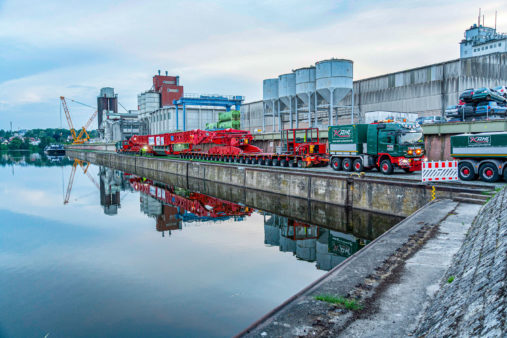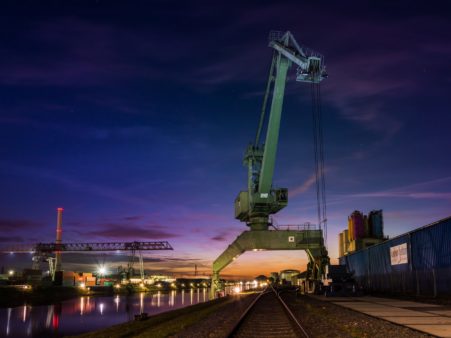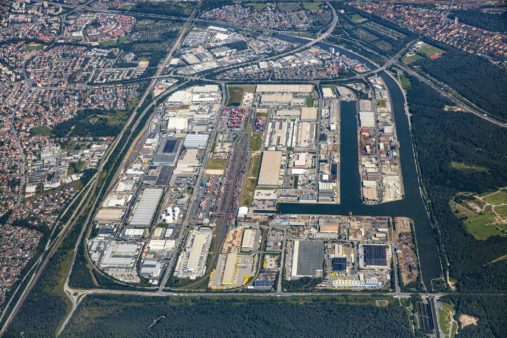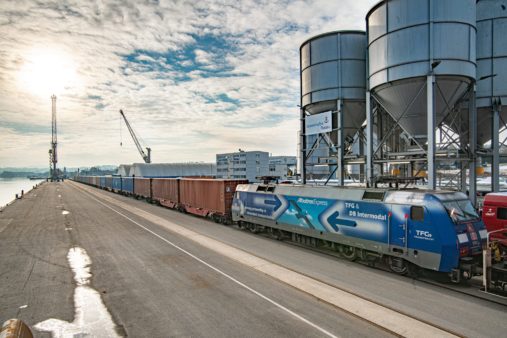11 March 2022 | bayernhafen
“The reliable supply of goods and environmentally friendly freight transport need the infrastructure that inland ports deliver”
2021 financial year: 9.15 million tonnes of goods moved by inland waterway and rail, up 4.6% on the previous year. Combined Transport throughput rises 22% to almost 500,000 TEU.
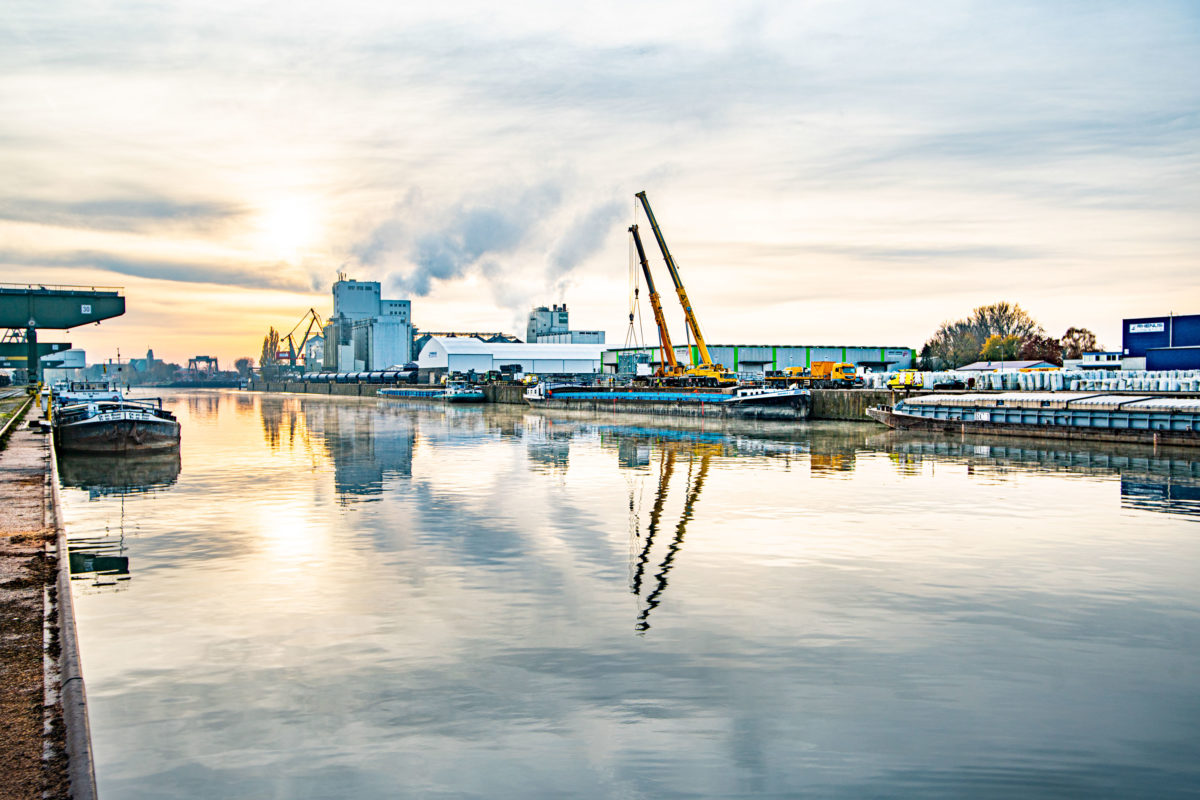
In 2021, the cumulative freight moved by rail and inland waterway at bayernhafen amounted to 9.15 million tonnes. bayernhafen comprises six locations: Aschaffenburg, Bamberg, Nuremberg, Roth, Passau and Regensburg (pictured). Image attribution: bayernhafen / M. Ziegler
Regensburg, 10 March 2022 – bayernhafen brings together a diverse range of goods and delivers the right infrastructure to meet the challenge of shifting long-distance traffic from the road networks to the two environmentally friendly transport modes of inland waterway and rail. In 2021, bayernhafen moved a total of 9.15 million tonnes of cargo and freight by inland waterway and rail at its six locations of Aschaffenburg, Bamberg, Nuremberg, Roth, Regensburg and Passau – a 4.6% increase on the previous year. This corresponds to around 535,000 fewer truck journeys.
Our inland ports and the infrastructure they provide ensure the reliable supply of goods to the region as well as the shift to the more environmentally friendly transport modes of inland waterway and rail.
Joachim Zimmernann
Chief Executive Officer of bayernhafen
6.396 million tonnes of goods were moved by rail in 2021, an increase of 14.3% on the previous year. Inland waterway handling stood at 2.755 million tonnes, 12.8% less than in the previous year. This was principally due to the fact that the higher water levels on the Danube in comparison to previous years meant that there was very little need for lightering services (transferring cargo from barge to barge) for inter-regional ship transport at the two Danube ports of Regensburg and Passau. Inland waterway and rail mainly transported goods such as agricultural produce, construction materials, foodstuffs and fuels as well as industrial goods, such as machinery, automotive parts and heavy-lift components such as transformers.
There was marked growth in Combined Transport, which increased 22% on the previous year. In 2021, total throughput across all of the bayernhafen locations amounted to 492,726 TEU (twenty-foot equivalent unit). In addition to containers for seaport-hinterland traffic, a rise was recorded in swap bodies and semi-trailers for continental cargo and freight transport – a segment with further potential for growth. Investment in the expansion of the terminals at the bayernhafen locations of Nuremberg and Regensburg will give Combined Transport a further boost.
“At each of the regions in which we operate we act as a hub for the import and export of goods and are a driver of the regional economy. Our inland ports and the infrastructure they provide ensure the reliable supply of goods to the region as well as the shift to the more environmentally friendly transport modes of inland waterway and rail,” says Joachim Zimmermann, the Chief Executive Officer of bayernhafen. “This requires investment in trimodal port infrastructure and the concentration of logistics companies at the ports. That is why we must emphatically reject the idea of restricting functioning port land through changes of use in the surrounding areas, or using port land for other purposes on a larger scale. In the spirit of mutual consideration, any existing restrictions need to be minimized.”
Our inland ports will play a key role in both the transition to cleaner modes of transport and greener energy sources in network systems.
Joachim Zimmernann
Chief Executive Officer of bayernhafen
“To help promote multimodal transport, we expect the new federal government to safeguard efficiency in planning and reliability,” says Joachim Zimmernann, the Chief Executive Officer of bayernhafen. “We need the same competitive conditions for all modes of transport. Rail is ideal for time-critical transport; this requires sufficient capacity in the rail-track network. For bulk goods and heavy-lift, inland waterway plays to its strength.” Zimmermann sees new opportunities in regenerative energy such as the transportation and storage of green hydrogen and synthetic fuels: “Our inland ports will play a key role in both the transition to cleaner modes of transport and greener energy sources in network systems.”
It is currently not possible for bayernhafen to estimate the extent of the impact the war in Ukraine will have on the economy and hence on the logistics sector and international supply chains, whether on container traffic, agricultural produce or the supply of raw material for industry.
New investment by port companies
A number of examples of investment by long-standing customers emphasise the key role locations play: Pollmeier is investing around € 35 million in a new high-bay warehouse and a timber cutting machine at bayernhafen Aschaffenburg. The new facilities are scheduled to commence operations in the summer of 2022. The development was made possible through the expansion of the site directly next to the existing factory. The new site is part of the former power station that site architect bayernhafen converted for use for industrial companies engaged in logistics-heavy activities. Pollmeier uses the infrastructure the port provides both to procure raw materials and to deliver products to its customers. The Geis Group is investing around € 25 million in a new logistics and technology centre at bayernhafen Nürnberg. The first phase involving the development of 15,000 m2 of office space went into operations in April 2021; the second phase followed in February 2022. A key factor is the direct proximity to the port and to the container terminal. In this case, the commercial space required was also developed through conversion.
Investment in port infrastructure
In 2021, bayernhafen once again maintained the high level of investment it had made over the previous years at all of its locations, spending around € 20 million in the redevelopment of its commercial sites and port infrastructure. The investment earmarked for 2022 will also reach the level of the previous years.
After inland waterway, rail and road, a key role in the future of inland ports and the logistics companies operating from these ports will be played by the ‘fourth infrastructure’, the ‘information superhighway’. Aschaffenburg is the next port after Nuremberg, Bamberg and Regensburg to obtain high-speed broadband internet, following the start of self-funded expansion work in October 2021 by the energy and infrastructure service provider, Entega Medianet GmbH.
The port experience – live!
bayernhafen Aschaffenburg celebrated its 100th jubilee in 2021. The next port to celebrate its birthday is bayernhafen Nürnberg, which turns 50 in 2022. Inaugurated in 1972 as part of the trans-European waterway between the North Sea and the Black Sea, bayernhafen Nürnberg is now one of the most important freight villages and logistics centres in Europe. It is a driver of employment in the region – the port secures around 7,000 jobs. In 2022, bayernhafen plans to invite members of the public to a series of festivals at its ports – Aschaffenburg in July and Nuremberg in September. The aim of ‘The port experience – live’ programme is to open the visitors’ eyes to the diverse world of logistics and to demonstrate the importance of inland ports to public at large.

